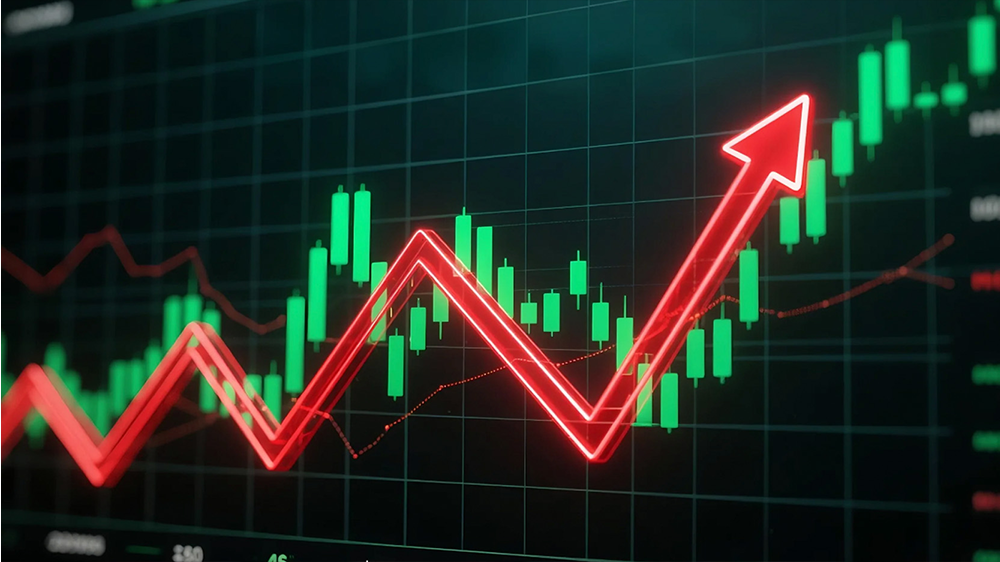What Is a K-Line? How to Uncover the Market’s Secrets?
What Is a K-Line? How to Read the Market’s Secrets?
In the ever-changing financial markets, every trader longs to gain foresight and understand the deeper meaning behind price movements. The K-line, a time-tested and widely used tool in technical analysis, serves as such a key that visually reveals the supply-demand dynamics and the battle between bulls and bears within a given period. This article will guide you through the essentials of K-line analysis, from its basic structure to its initial applications, helping you build a solid foundation in chart reading. Together, let’s explore how K-lines allow you to listen more clearly to the voice of the market.
What Exactly Is a K-Line?
To grasp the essence of the K-line, we must first trace its origins and understand the historical background of its creation. This not only deepens our respect for this analytical tool but also helps us appreciate the market philosophy behind its design.
The Origins of the K-Line
The K-line chart, also known as the Japanese Candlestick Chart, dates back to 18th-century Japan.
It was invented by a rice merchant named Honma Munehisa, who sought to forecast rice price fluctuations. By observing changes in market prices and plotting them into graphical form, Honma aimed to identify patterns that would give him an edge in trading.
The design of this chart was intended to visually represent price movements and the underlying market sentiment within a specific time frame. It condensed four key data points which are open, high, low, and close into a single, “candle” shape, making it easy to see not only whether prices rose or fell, but also the magnitude of the move and the balance of power between buyers and sellers. Having withstood centuries of market testing, K-line charts have not only survived but thrived, thanks to their ability to reflect both market psychology and the fundamental forces of supply and demand. To this day, it remains a widely relied-upon analytical tool for traders in global stock, futures, and forex markets. Its origin in rice trading, which is a fundamental commodity demonstrates that K-line analysis has a fundamental applicability in capturing market dynamics driven by supply-demand relationships and collective psychology, extending far beyond modern complex financial derivatives.
K-line charts were later introduced to the Western world and popularized by figures such as Steve Nison, eventually becoming a core component of modern technical analysis. Even in today’s highly digital and information-driven financial markets, the K-line remains a powerful and enduring tool.
How to Interpret a Single K-Line
Each individual K-line is a concise summary of price action within a specific trading period. To properly read a candlestick chart, you must first understand the four core price points that make up a single K-line:
- Open: The first traded price at the start of the period.
- Close: The last traded price at the end of the period.
- High: The highest traded price within the period.
- Low: The lowest traded price within the period.
These four price points together outline the full range of price movement within a trading period and give an initial indication of the dominant market trend during that time. Among them, the position of the close relative to the open is especially critical, as it directly determines whether the candlestick is bullish (a rising candle) or bearish (a falling candle). If the close is higher than the open, the candlestick is bullish; conversely, if the close is lower than the open, it is bearish.
These data points are not isolated figures, they tell the “story” of the tug-of-war between buyers and sellers during that period. The span between the high and low reflects the level of activity or volatility in the market, showing how far each side was able to push prices. The relationship between the open and close, and the candlestick body it forms, reveals the interim outcome of this battle—showing which side held the upper hand during that trading period.
When traders move from interpreting a single candlestick to analyzing the relationships among multiple consecutive candlesticks, they shift from static data points to dynamic market insights. This progression marks the true starting point of candlestick pattern analysis.
What Do the Candlestick “Body” and “Wicks” Reveal About Market Forces?
A single candlestick is mainly composed of two parts: the rectangular area in the middle is called the body (Body), while the thin lines extending above and below the body are called the wicks/shadows.
The candlestick body is the rectangular area formed by the opening price and the closing price of that period. The color and length of the body are important indicators for judging market direction and strength. Generally, if the closing price is higher than the opening price, the candlestick is bullish, which may be shown in green or white, representing a price increase; if the closing price is lower than the opening price, the candlestick is bearish, which may be shown in red or black, representing a price decline.
The length of the body directly reflects the strength of the market’s rise or fall: a long body usually means a strong trend, with buyers or sellers holding an absolute advantage; while a short body may indicate that market momentum has weakened, or that both buyers and sellers are in a relatively balanced and hesitant state.
The wicks represent the price movement beyond the range of the opening and closing prices within that period. The thin line above the body is called the upper wick, with its top being the highest price of the period; the thin line below the body is called the lower wick, with its bottom being the lowest price of the period. The length of the wick reveals the opposing pressure encountered when the price reaches extreme levels. For example, a candlestick with a long upper wick may suggest that during an upward push, selling pressure appeared at higher levels and successfully pushed the price back down, indicating the presence of selling pressure above. Conversely, a candlestick with a long lower wick may indicate that during a downward move, buying forces actively intervened at lower levels and provided support, causing the price to rebound.
Different combinations of bodies and wicks can form a variety of candlestick patterns with specific preliminary implications. For instance, when the opening and closing prices are very close, resulting in a very small or even nonexistent body, while potentially showing both upper and lower wicks, the resulting “Doji” pattern is often interpreted as a signal of market indecision, where buying and selling forces are temporarily in balance. On the other hand, a “Hammer” candlestick, which appears in a downtrend with a long lower wick and a small body, may indicate a potential bottom reversal signal. These are only preliminary descriptions of the patterns, and their true meaning must be judged in conjunction with the broader market context.
Why Have Candlestick Charts Become an Indispensable Tool for Traders?
The primary reason candlestick charts are so widely used lies in their unmatched visual clarity. Compared with other types of charts, candlestick charts can convey market information in an extremely efficient way.
How Do Candlestick Charts Make Market Dynamics Instantly Clear?
One of the most notable advantages of candlestick charts is their ability to combine four key price data points—open, high, low, and close—into a single, simple, and intuitive graphical symbol. Compared with traditional line charts or bar charts, which also include the four price points, candlestick charts are far easier to distinguish visually in terms of direction and body size, offering richer and more immediately interpretable market information.
The color and shape of the candlestick body allow traders to quickly identify whether the market is in an uptrend, downtrend, or sideways movement within a specific period, as well as to make an initial judgment about the relative strength of the trend. For example, a series of long bullish candles may indicate a strong upward trend, while a series of long bearish candles could signal a potential downtrend. This “at-a-glance” feature greatly reduces the cognitive load required to process and interpret price information in a fast-moving market. In a trading environment where every second counts, the ability to quickly assess price action and market sentiment is an undeniable advantage to make quicker decisions.
In addition, the learning curve for candlestick charts is relatively gentle, even traders that are new to the market can grasp basic reading techniques and understand the meaning of a single candlestick and some common patterns in a short period of time. This ease of learning and universality makes candlestick charts a foundational entry point in the field of technical analysis. On a deeper level, the widespread adoption of candlestick charts and the standardization of their visual elements have created a shared “chart language” within the global trading community.
When a large number of traders focus on the same candlestick patterns and act on similar interpretations, this collective behavior itself can sometimes influence market prices, creating a degree of “self-fulfilling expectation”. For example, if many traders buy simultaneously when a widely recognized bullish candlestick pattern appears, they may push the price in the anticipated direction. This also suggests that the effectiveness of candlestick charts may stem from the market interaction driven by this shared perception in some parts.
What Are Candlestick Patterns?
When multiple candlesticks are arranged in a specific order and shape, they can form candlestick combinations with particular market implications which are known as candlestick patterns. Many traders regard these patterns as reference points for identifying shifts in market sentiment and potential trend reversals or continuations. It is important to emphasize that the following are purely objective descriptions of candlestick patterns and the general market sentiment they have historically indicated. They are not trading strategies nor guarantees of future results.
Some common and representative candlestick patterns include:
- Bullish Engulfing and Bearish Engulfing: These two patterns are both formed by two consecutive candlesticks. In a Bullish Engulfing pattern, the second candlestick is bullish, and its body completely covers (engulfs) the body of the preceding bearish candlestick. This is often interpreted as a strong surge in buying power after a downtrend or consolidation, potentially signaling the start or continuation of an upward move. Conversely, in a Bearish Engulfing pattern, the second candlestick is bearish, and its body fully engulfs the body of the prior bullish candlestick. This is typically seen as a significant strengthening of selling pressure, possibly foreshadowing the beginning or continuation of a decline. At its core, the Engulfing pattern vividly illustrates a decisive shift in market control from one side to the other across two trading periods.
- Doji: The hallmark of a Doji is that the opening and closing prices are very close to each other, leaving the candlestick body extremely short, nearly a flat line. It may feature upper and/or lower wicks of varying lengths. A Doji generally signals indecision or balance between buyers and sellers during that period, with the existing trend possibly pausing. While it does not inherently predict the next direction, when it appears after a pronounced trend, it may suggest weakening momentum and a market searching for new direction.
- Hammer & Hanging Man: These two candlestick patterns look visually similar: both feature a small body near the top of the candlestick and a relatively long lower wick (often at least twice the length of the body), with little or no upper wick. Their key distinction lies in their market context and implications. A Hammer typically appears after a downtrend, with the long lower wick showing that prices fell sharply during the session but buyers stepped in to push them back near the opening level often read as a potential bottom reversal signal. However, the hanging man pattern is the same as the Hammer in appearance which occurs at the top of an uptrend. While it has the same structure, its long lower wick in this position may suggest that despite making a new high, selling pressure emerged, and buyers failed to maintain control, often seen as a potential top reversal warning.
It must be reiterated that the appearance of any single candlestick pattern or combination only provides a possibility hint, rather than a definitive trading signal. Their interpretation needs to be closely integrated with the overall market trend, the price region in which they occur, changes in trading volume, and signals from other technical analysis tools for a comprehensive judgment. The true value of learning these patterns does not lie in finding a foolproof predictive tool, but rather in training traders to recognize the recurring psychological battles in the market. By becoming familiar with these patterns, traders can gradually develop an intuition for how market participants may react under specific pressures or opportunities. This serves as the foundational step toward a more refined and mature ability to read charts.
How Should Candlestick Knowledge Be Initially Applied in Actual Trading?
The patterns and meanings of candlesticks are influenced by the time period they represent. Therefore, selecting the appropriate trading timeframe to observe candlestick charts is an important aspect in practical application.
What Insights Do Candlesticks Provide Across Different Timeframes?
An important characteristic of candlestick charts is their applicability to price data analysis across any time period. Whether it is minute-based charts (such as 1-minute, 5-minute, or 15-minute candlesticks) for tracking intraday short-term fluctuations, hourly or daily charts for focusing on medium- to short-term trends, or weekly and monthly charts for capturing long-term market movements, candlesticks can be used to display and analyze them.
Candlestick charts of different time periods reflect the evolution of market trends at various levels and the behavioral characteristics of different types of participants. For example, long-term investors or institutional traders may place greater emphasis on analyzing weekly and monthly charts to identify macro market directions and major turning points. Meanwhile, intraday or short-term swing traders may focus primarily on shorter timeframes such as hourly or minute charts to capture price movement opportunities within the day or over a few days.
In general, candlestick patterns that have longer time frames are considered more reliable. This is because they encompass trading data over a longer span of time, aggregating the behavior of more market participants, and thereby filtering out part of the short-term market noise and random fluctuations to some extent. The formation of a single daily candlestick embodies the collective wisdom and power struggle of all traders throughout the day; while a weekly candlestick summarizes an entire week’s trading. Therefore, key candlestick patterns appearing on longer-term charts often represent the mainstream market opinion and the solidity of the trend more effectively. The choice of timeframe for candlestick analysis fundamentally changes the “resolution” of market observation. Shorter timeframe candlestick charts display more market “noise” and rapid price swings, whereas longer timeframe charts smooth out these short-term fluctuations to reveal more significant and lasting trends.
Many experienced traders combine candlestick charts of multiple timeframes, seeking to gain a more comprehensive and three-dimensional view of the market from different perspectives. For example, they may first determine the main trend direction on a longer-term chart, and then look for specific candlestick entry signals that align with the broader trend on shorter-term charts. However, beginners should be cautious not to overcomplicate their analysis and can initially focus on just one or two primary timeframes.
Market price fluctuations often exhibit similar patterns across different time scales, which is referred to as the “fractal nature” of markets. This means that similar candlestick patterns can appear across all timeframes, but their implications for holding time, risk management, and profit targets differ greatly. For example, both an intraday trader and a swing trader may see the exact same “Hammer” pattern on their charts. However, if the former sees it on a 5-minute chart while the latter sees it on a daily chart, the resulting trading decisions, stop-loss and take-profit settings, and expected holding periods will be entirely different. Therefore, the interpretation of candlestick signals must be placed within the context of the chosen timeframe and aligned with the trader’s own trading style, risk tolerance, and investment objectives.
Limitations of Candlestick Analysis: How to Objectively Assess Its Reference Value?
Although candlestick charts provide traders with a powerful perspective to gain insights into market dynamics, it is important to recognize that they are not flawless crystal balls for prediction. Like any technical analysis tool, candlestick analysis has its inherent limitations. Viewing its reference value objectively helps traders incorporate it into decision-making more rationally.
First, candlestick patterns are a record and reflection of historical price behavior, and past performance does not guarantee future results. Market environments are dynamic, and patterns that once worked may fail in the future or perform differently under varying market conditions.
Second, the interpretation of candlestick patterns is to some extent subjective. While there are widely accepted definitions of patterns, the degree of perfection in real charts, the exact location where they appear, and the surrounding market environment may all affect how traders judge their meaning. Experience and personal preferences can lead to different interpretations of the same set of candlesticks.
Furthermore, in markets with poor liquidity or where prices are easily influenced by non-market factors (such as breaking news, policy intervention, or even market manipulation), the reliability of candlestick patterns may be significantly reduced. In such cases, price fluctuations may reflect special events rather than normal supply-demand dynamics or psychological battles, thereby diminishing the effectiveness of candlestick analysis based on historical patterns.
In addition, candlestick analysis itself mainly focuses on price action, and it does not directly include all the factors that influence market prices, especially fundamental factors such as the release of macroeconomic data, the disclosure of corporate financial reports, industry development trends, and geopolitical events. These fundamental factors are often the underlying drivers of long-term market trends, whereas candlestick analysis is more about capturing the short-term or medium-term reflection of these factors in price movements.
Therefore, the wisest approach is to regard candlestick analysis as one component of a comprehensive decision-making process, rather than the sole basis. It is recommended to combine candlestick patterns with other technical indicators (such as moving averages, the Relative Strength Index RSI, Bollinger Bands, etc.) in order to achieve multi-angle confirmation and improve the comprehensiveness and reliability of the analysis.
These limitations precisely highlight one point: candlesticks are tools for probabilistic thinking, not means of deterministic prediction. They provide clues intended to enhance the assessment of the likelihood of certain market outcomes, but they never offer 100% certainty. For traders, building this probability-based mindset is crucial.
Conclusion
As a classic and powerful technical analysis tool, candlestick charts provide traders with a window into market psychology and price momentum. From understanding the four basic price points of a single candlestick, to recognizing the meaning of bodies and shadows, and then to initially exploring common candlestick patterns, each step is about accumulating the vocabulary to decode the “secret language” of the market.
However, as stated in this article, candlestick analysis is not omnipotent. The interpretation of its patterns requires objectivity, and the confirmation of its signals demands caution. Any candlestick pattern should always be placed within the broader market context and combined with other analytical tools and risk management principles in order to maximize its reference value. Learning candlesticks is a process of continuous refinement, and readers are encouraged to go beyond the basics covered here to further explore more complex candlestick combination theories, multi-timeframe analysis techniques, and how to integrate candlestick analysis into a personalized trading system.
As you begin to practice candlestick analysis and embark on or continue your trading journey, Cashback Island is ready to be your trusted partner in reducing trading costs, providing professional insights, and delivering practical tools, witnessing your growth and progress in the financial markets.
Cashback Island continuously updates trading education resources. Traders can visit the “Cashback Island Education Guide” section to gain more forex knowledge and investment techniques.
Cashback Island continuously updates trading education resources. Traders can visit the “Cashback Island Education Guide” section to gain more forex knowledge and investment techniques.
Frequently Asked Questions
Q1. What Are the Basic Components of a Candlestick?
Each candlestick includes the open, close, high, and low prices. The body reflects the difference between the open and close, while the wicks show the extreme price range during the trading session.
Q2. What Market Signal Does a Doji Pattern Represent?
A Doji often appears at potential trend reversal points. Its upper and lower wicks indicate strong tug-of-war between bulls and bears, possibly suggesting consolidation or reversal. It must be judged together with the surrounding candlesticks and the overall trend.
“Trading financial derivatives carries high risk and may result in capital loss. The content of this article is for informational purposes only and does not constitute investment advice. Please make decisions cautiously based on your personal financial situation. Cashback Island assumes no liability for any trading-related consequences.”
Related Articles
-
What Are Bollinger Bands? An Indispensable Volatility Guide in Your Trading Toolbox The financial market is known for its ever-changing nature, and for any trader, understanding market volatility is a key part of navigating these complexities. Among the many technical analysis tools, Bollinger Bands have become an important reference for...2025 年 10 月 1 日
-
Forex and Cryptocurrency, Which Market Should Beginners Choose? Many new investors often feel uncertain when choosing between the traditional foreign exchange market and the emerging cryptocurrency market. Both offer unique opportunities but also carry their own risks. This article will outline the core characteristics of these two markets to help...2025 年 10 月 1 日
-
Forex rebate, also known as forex cashback, refers to the portion of trading fees (mainly in the form of spreads or commissions) charged by brokers during forex trading that is returned to clients by agents (or Introducing Brokers, IB). This effectively reduces clients’ trading costs. It is widely understood as...2025 年 9 月 9 日












